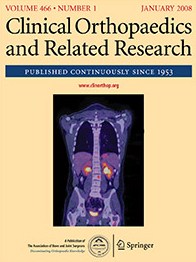
ARTHROPLASTY
Limited/no tourniquet use beneficial for quadriceps strength vs tourniquet in TKA
This report has been verified
by one or more authors of the
original publication.
Clin Orthop Relat Res. 2016 Jan;474(1):69-77
32 patients scheduled for bilateral total knee arthroplasty (TKA) were randomized to have the procedure of one knee performed under tourniquet control, with the procedure of the other knee performed with either limited tourniquet use or no tourniquet use at all. Outcomes of interest included quadriceps strength, quadriceps activation, hamstrings strength, unilateral limb balance, and clinical examination measures (knee range of motion, swelling, pain). Assessments were made preoperatively, at 3 weeks, and at 3 months postoperatively. The only significant between-group difference that was observed was in quadriceps strength, which was significantly lower at both 3 weeks and 3 months following procedures performed using a tourniquet versus procedures with limited or no tourniquet use.
Unlock the full ACE Report
You have access to {0} free articles per month.Click below to unlock and view this {1}
Unlock NowCritical appraisals of the latest, high-impact randomized controlled trials and systematic reviews in orthopaedics
Access to OrthoEvidence podcast content, including collaborations with the Journal of Bone and Joint Surgery, interviews with internationally recognized surgeons, and roundtable discussions on orthopaedic news and topics
Subscription to The Pulse, a twice-weekly evidence-based newsletter designed to help you make better clinical decisions
Exclusive access to original content articles, including in-house systematic reviews, and articles on health research methods and hot orthopaedic topics
Or upgrade today and gain access to all OrthoEvidence content for just $1.99 per week.
Already have an account? Log in


Subscribe to "The Pulse"
Evidence-Based Orthopaedics direct to your inbox.
{0} of {1} free articles
Become an OrthoEvidence Premium Member. Expand your perspective with high-quality evidence.
Upgrade Now













































































